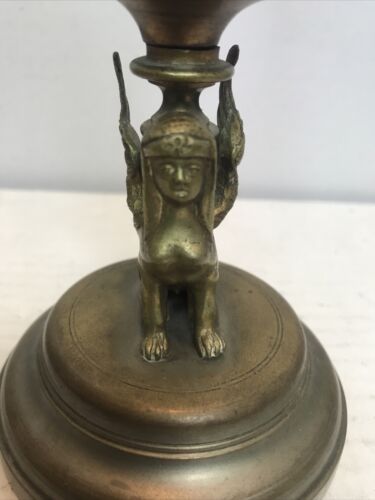-40%
Antique Brass 19 Century Winged Sphinx Scroll Megalith Thermometer.Amazing!
$ 105.58
- Description
- Size Guide
Description
1914) up for your consideration is this Unmarked Antique Brass 19 Century Winged Sphinx Egyptian/ Greek Scroll Megalith Thermometer.A True Survivor!. The thermometer measures approximately 3 1/4“ x 3 1/4“ x 8 1/2“. It is in amazing condition with superb brass patina. Unfortunately it’s missing its glass thermometer which could easily be fixed and replaced. There’s two screws that hold the thermometer plate to the scroll.And I’m sure with a little legwork you could probably find a vintage one for this purpose. After going through it with a magnifying glass I could not find a maker stamp or anything even close. And my research has not found its equal. Could be one of a kind! It is sold in as is condition no guarantees!A sphinx is a mythical creature with the body of a lion, most often with a human head and sometimes with wings. The creature was an Egyptian invention and had a male head - human or animal; however, in Greek mythology, the creature had the head of a woman. The sphinx is also present in the art and sculpture of the Mycenaean, Assyrian, Persian and Phoenician civilizations.
Egyptian Sphinxes
Sphinxes were first created by the Egyptians and usually wore a nemes (head-dress) as worn by Pharaohs. Examples exist of sphinxes with human faces but surrounded by a lion's mane, particularly from Nubia, and in the New Kingdom the head was sometimes that of a ram and representative of Amun. The exact date when the first sphinx appeared is not known and the most famous sphinx of all, the Great Sphinx of Giza, has not been precisely dated; some scholars date it as far back as the reign of Cheops, ca 2500 BCE. There is a story that in the Eighteenth Dynasty, Pharaoh Thutmose IV, when he was a mere prince, went on a hunting expedition and fell asleep in the shadow of the Sphinx. Whilst asleep he dreamt that the Sphinx spoke to him and promised that he would become king if he cleared the sands that had accumulated around the feet of the statue. In the reign of Chephren, sphinxes became more widespread and they were usually placed as guards outside or beside a mortuary temple, tomb or funerary monument. Everything indicated and photographs. Thanks for taking a look!



















